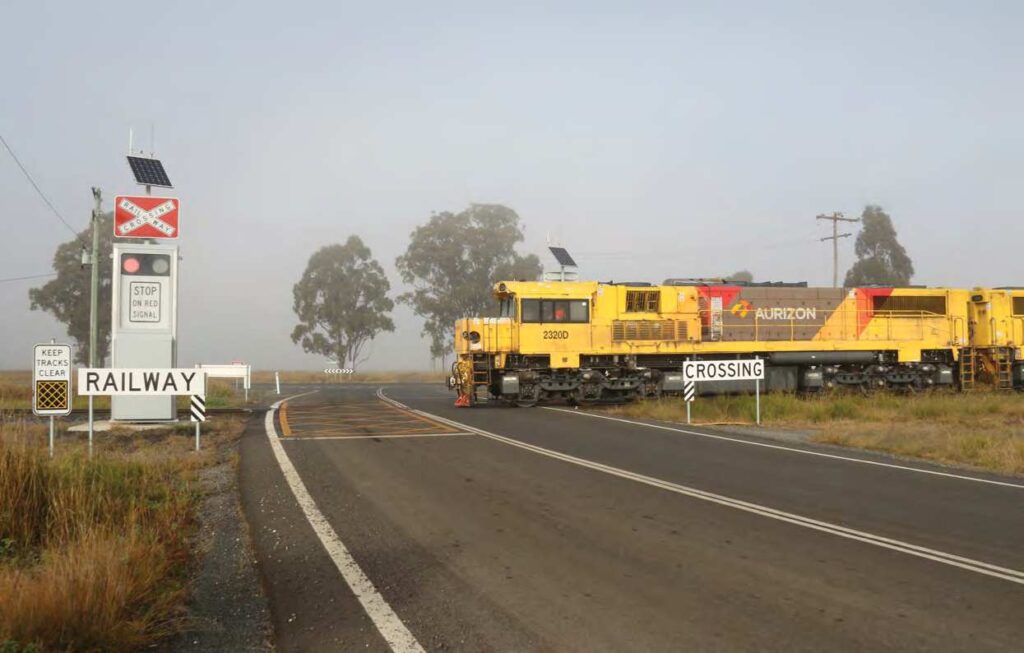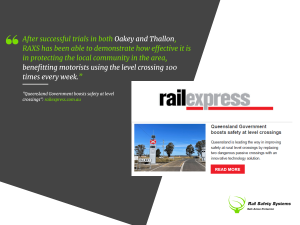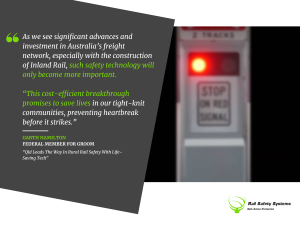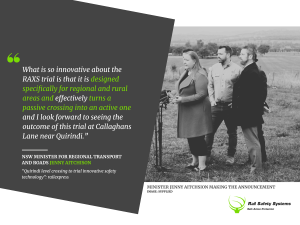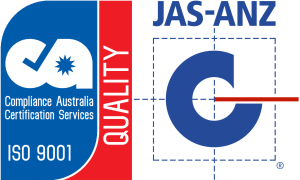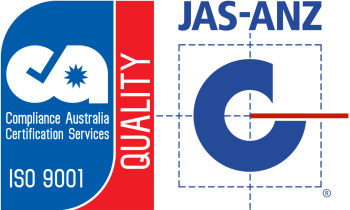“The best level crossing is a permanently closed one”. These words are sometimes expressed by railway managers frustrated with the rising severity of collisions between trains and motor vehicles in recent decades. Level crossing collisions remain a serious concern for the rail industry and the situation has worsened with not only growth in road traffic levels but the significant increase in size and weight of trucks which can result in serious damage and fatalities in train/truck collisions.
To add to rail’s challenges media coverage of level crossing collisions has often not been kind to rail, reflecting both the power of the car culture in Australian society and the resultant disconnection between railways and much of the wider community, including journalists. Media coverage sometimes implies that it is the fault of the train or the level crossing and never the motorist or truck driver when a road/rail collision occurs. This may not be deliberate but simply a reflection of cultural values.
The issue of level crossing media coverage was illustrated last year by segments on the ABC’s Landline and 7.30 programs, which featured a person who had tragically lost a loved one in a level crossing collision. These programs did, quite rightly, discuss improvements to train visibility and level crossing design, including more active protection (lights and boom gates) for level crossings. A train driver was interviewed as part of the Landline program, but the issue of motorist behaviour was overlooked. It should be stressed that any focus on motorist behaviour does not diminish the importance of looking at issues such as train visibility, level crossing design and the provision of active crossing protection and indeed this article is primarily about steps towards improvements in this area.
Dramatically illustrating the need to include motorist behaviour in any level crossing discussion, the Australian Rail Track Corporation commissioned road camera technology developer Acusensus from late last year to monitor level crossings in regional New South Wales at Culcairn, Scone and Red Bend near Forbes. Each crossing is protected by “stop” signs with no active controls. Non-compliance was highest at Culcairn with more than half (1015) of the 1923 motorists using this crossing throughout December last year failing to stop. Many were repeat offenders, with 130 vehicles responsible for 604 non-compliant crossings.
The eight-week trial at Scone from mid-April caused similar alarm, with half of the 5673 vehicles failing to stop, including 86 large trucks.
At Red Bend almost one in three (7403) of the more than 25,000 vehicles using the Red Bend crossing between December and March ignored the stop signs and continued across the crossing. A high rate of repeat offenders – 965 vehicles – were responsible for 4918 (66 per cent) of non-compliant crossings. Alarmingly, a large number of trucks also failed to stop, including 345 road trains. Acusensus managing director Alexander Jannink said the level of non-compliance with warning signs was worrying and showed more needed to be done to educate motorists of the potential dangers level crossings posed to the safety of both vehicle and train occupants. The findings also support the need to accelerate deployment of actively controlled level crossings.
An earlier investigation into driver behaviour at level crossings, supported by the CRC for Rail Innovation and Queensland Rail was undertaken by Li-Sian Tey and Luis Ferreira in 2010 using hidden camera monitoring at four level crossings in south east Queensland.1 Four sites were selected, two with passive protection (stop signs), one with flashing lights and bells and one with flashing lights, bells and boom gates. Monitoring at the two sites equipped with stop signs revealed that more than half (59 per cent) of motorists did not fully stop, although 41 per cent of this non-compliance group did slow down before crossing the tracks. For sites three and four with active systems driver compliance rates (speed reduction) after the warning systems were activated were 70 per cent and 77 per cent respectively but no “near miss” situations were revealed. These results showed, as expected, that motorist compliance levels at passive (stop/give way signed) level crossings were considerably lower than at active crossings.
Another research project supporting the worth of actively controlled level crossings but noting the additional safety derived from the installation of boom barriers as well as flashing lights was presented in a paper by
Eric Wigglesworth and Charles Uber in 1991.2 The paper evaluated the effectiveness of a program carried out in Victoria in which 91 metropolitan and major urban road level crossings were upgraded from “flashing light” status to “boom barrier” status during a 19-year period from 1971 to 1989. At these crossings the number of deaths from motor vehicle/train collisions was reduced from 61 before boom barrier installation to two thereafter.
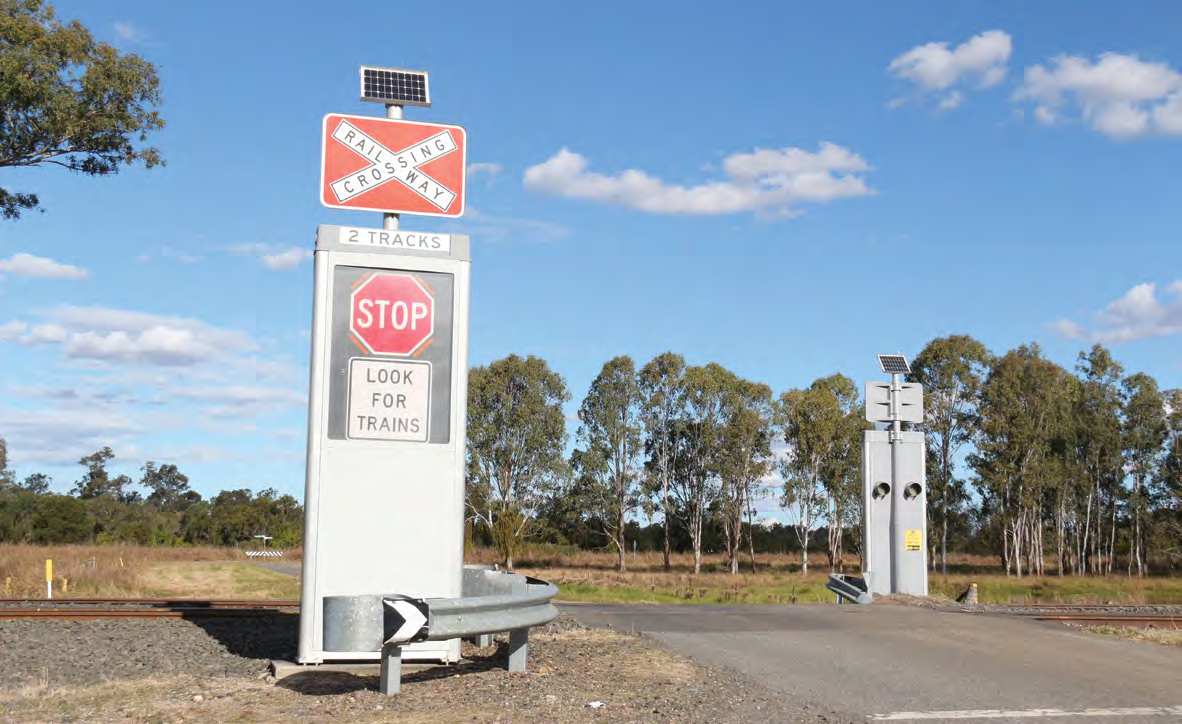
However, providing active level crossing protection at level crossings is not cheap and costs have escalated in recent years.
Given that each level crossing has its own physical characteristics it is difficult to provide an estimate of level crossing costs. Melbourne-based Rail Safety Systems (RSS) suggests that the provision of a flashing light crossing is currently costing around $900,000 in a metropolitan area but in a remote area it could be up to $1.2 million. If boom barriers are required, it would add around another $500,000. RSS claims it could provide equivalent crossing protection using its Rail Active Crossing System (RAXS) at around half the cost through various measures including wireless technology and solar power. RSS says a complete installation can be installed in around one week.
According to the Australian Level Crossing Assessment Model (ALCAM) there are over 19,000 level crossings in Australia (2019 figure). ALCAM is the assessment tool which is used across Australia and New Zealand by rail and road managers to identify key potential risks at level crossings and assist in the prioritisation of crossings for upgrades. There are calls for every level crossing in Australia to be equipped with active protection but financially this would be extremely challenging for any government to implement.
Notwithstanding the reality that active protection will probably never be provided at all level crossings the rail industry and road traffic authorities have actively pursued the goal of developing low-cost solutions for active level crossing protection, especially as the previous- ly-mentioned studies indicate that motorist compliance rates are higher than at passively protected crossings. Traditional active level crossing systems and the accompanying train detection systems generally rely on mains power or large-scale solar installations and extensive (and expensive) trenching and cabling on either side of the crossing, often around a kilometre or more, is used to provide track circuits to activate crossing equipment. The design and provision of cheaper, yet reliable active level crossing protection that meets safety standards has become a prized goal for the rail industry.
The road towards the RAXS system mentioned above started in 2015 with the Queensland Department of Transport and Main Roads requesting expressions of interest for innovative solutions for level crossing protection. Rail Safety System’s predecessor, Railnet Safety Systems, was the successful respondent and manufactured and installed a trial flashing light warning system at Lane Road, Lanefield, west of Ipswich in southern Queensland on a double track section of Queensland Rail’s (QR) Western Line. A second and similar arrangement was then installed at the Carnarvon Highway level crossing at Thallon, terminus for QR’s south western line. Both the Lanefield and Thallon trial installations were subsequently decommissioned and converted to stop signs after trials were completed but the experience was applied by RSS to install its fully-developed RAXS at the Devon Park Road crossing, just under five kilometres west of Oakey on Queensland Rail’s Western Line.
RAXS comprises two main components. The first is Active Trackside Road Signs (ATRS) which provide an LED flashing light warning to motorists that a train is approaching the crossing and secondly a Train Detection Node (TDN) which is combined with Frauscher SIL 4 axle counter technology using electromagnetic principles that activate the crossing control measures via wireless communication. This eliminates expensive trenching and cabling to link the train detection (or “strike point”) site with the ATRS. The TDNs can be located at any suitable distance away from the crossing to provide sufficient warning for approaching trains, depending on train speeds. Radio repeaters can be used to ensure the radio signal from the TDNs to the ATRS is reliable over a longer distance.
The level crossing at Lane Road, Lanefield, west of Rosewood, was equipped with flashing lights as part of a pilot project launched in 2015 involving Queensland Transport and Main Roads and Rail Safety Systems predecessor, Railnet Safety Systems. With the completion of the trial the crossing warning lights were de-activated and converted to stop signs as seen in this 18 June 2022 view. A similar installation was installed at the south western Queensland town of Thallon.
RAXS is fully software controlled, contains no relays and is configured using a simple configuration file with no programming required and employs a dual processor for safety. The RAXS has provision for radio-linked Active Early Warning Signs that can be installed, for example, up to 1200 metres from the crossing to provide early indication to motorists that a train is approaching the crossing and that flashing lights will soon be activated.
Rail Safety Systems Pty Ltd (RSS) received type approval in February this year for RAXS, meeting CENELEC SIL 3 standards. CENELEC is the European Committee for Electrotechnical Standardization and SIL, or Safety Integrity Level, and is based on the value of risk reduction associated with a Safety Instrumented Function protecting against a hazardous event. The RAXS is at present the only SIL 3 active system of its kind in Australia. RSS engaged engineering service provider Acmena in 2018 to provide systems assurance and safety management support as RSS developed RAXS.
An innovative feature of RAXS is its patented Fail to Safe-Stop Sign Mode that presents a traditional stop sign to the motorist whenever a critical failure is detected or the system loses all power. The stop sign is held out of sight by electromagnets but when the system fails the sign is released to rise to cover the non-operating lights but to ensure motorists are aware of the changeover to the stop sign, flashing amber lights surround the sign. These are powered by a separate battery should the solar power fail.
Traditional active level crossing systems do not always offer a safe state when they fail presenting potentially dangerous conditions for road users. For example, a crossing may “fail” in that its flashing lights operate for a considerable period although no trains may be in the area, encouraging motorists to cross against the flashing lights. During the type approval process human factors trials were conducted to confirm that the RAXS stop signs were at least as good as a regular stop sign in enlisting safe driver behaviour at the level crossing. With the assistance of the Queensland Transport and Main Roads Department this innovation has now resulted in changes to the Manual of Uniform Traffic Control Devices standard.
The entire RAXS is powered by solar/batteries with each node (ATRS and TDN) having its own solar panel and batteries. Battery capacity is sized for at least 10 days of “no light” operation. Dual parallel batteries provide redundancy and capacity and the solar system is fully monitored remotely for fault and performance, including any solar panel fault.
As mentioned earlier the use of wireless communications for the RAXS applications eliminates expensive cabling costs and reduces installation time and costs while still providing high integrity for signalling data. The system employs dual wireless modems (the system will operate on one modem) and the modems operate in completely separate frequency bands use spread spectrum technology and employ fully encrypted messages with a safety code.
ATRS include a mobile network modem for remote logging of alarm, performance and train movement data. A Remote Crossing Management System (RCMS) receives and logs the RAXS level crossing data to a database and RCMS onforwards the RAXS alarm status to the Rail Operators Fault Management System. RCMS has a Web portal for viewing current and historical data and it can be used to diagnose a fault down to the node and device. Communication over the mobile network is fully encrypted for security. Should the mobile network be unavailable, then the ATRS will buffer-up the data for more than 30 days to send at the next available time. The mobile phone network is used purely for fault data transmission and is completely separate from the radio links between the level crossing components.
Another cost-saving feature employed in the installation of RAXS is the use of concrete-free footings by employing a system of piles driven direct into the earth. The piles support steel plates and the ATRS and TDN units are in turn bolted to the plates. The piles and plates are an innovation developed by Melbourne-based company Surefoot. RSS says this system eliminates the need for excavations, formwork and concrete pours and an installation can be done in hours rather than days. At the Devon Park Road installation one of the ATRS has been installed on a concrete base but this was done because of the proximity of a Telstra cable.
ATRS are located at roadside and have thus been designed to be frangible thereby reducing the risk of serious injury to road users upon impact and reducing costs by eliminating the use of guard rails. An ATRS was independently crash tested at 100kph at a registered crash test facility.
RSS says its RAXS has been designed for minimal maintenance and with remote monitoring capability (system alarms can be monitored 24/7 by the rail operator), maintainers can remotely diagnose a fault cause using the RCMS to ensure the right spares and activities can be planned – improving the effectiveness of maintenance visits. Maintenance should typically involve: exercising the Fail to Safe functionality, cleaning the signage and solar panels, vegetation clearance, key switch operation, inspection of the axle counter systems and general system operation on site. In the case of the Devon Park Road crossing Queensland Rail provides all maintenance with staff trained by RSS.
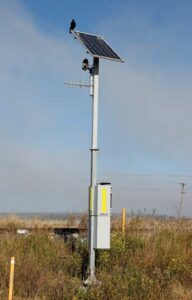
to the Devon Park Road level crossing. The solar panel, radio antennae and equipment/battery cabinets can be seen in this view taken on 16 June. The TDN is activated by a Frauscher axle counter on the track.
The type approval trial at the Devon Park Road crossing took place over eight months and involved the passage of over 2,000 trains and more than 100 hi-rail/on track vehicles. Queensland Rail has already committed to a second RAXS installation at Thallon, terminus for the south west line, replacing the previously-mentioned trial installation. This project is expected to be undertaken in the summer of 2022/2023.
RSS is also developing a boom gate version of RAXS and audible warning equipment can be added if required. The company says it is in talks with other Australian rail infrastructure managers to obtain certification for RAXS and interest in the concept has come from organisations in New Zealand, Canada and the United States. According to RSS Managing Director Dagmar Parsons a lot of time, effort and money has been invested in developing the system and putting it in to the Australian rail network.
RSS is not the only organisation involved in searching for a low-cost active level crossing protection system and improved active level crossing reliability. For example, V/Line has installed a system near Bairnsdale which uses solar power, radio linkages instead of cabling and axle counters to reduce installation and whole of life costs. Rail infrastructure managers have increased the use of axle counters to activate crossing protection to overcome reliability problems with track circuits in certain situations. V/Line had experienced problems with its Sprinter and Vlocity DMUs and their interaction with track circuits.
In February 2021 the Australian Transport Safety Bureau commenced a safety study into level crossing collisions involving trains and heavy road vehicles in Australia. ATSB Director Transport Safety Dr Michael Walker said there were 11 collisions between heavy road vehicles and trains at level crossings across Australia between July 2020 and June 2021, and 23 such collisions over the previous five years. The study, which is on-going, includes a review of previous collisions to determine their characteristics and circumstances, and also determine if there are any unidentified systemic safety issues or learning opportunities that could enhance the safety of future transport operations.
The Rail Industry Safety and Standards Board (RISSB) has been involved in level crossing safety research and is currently finalising an ALCAM validation and enhancement project to improve the way roads information is accounted for in the model to add to its robustness.
RISSB is also delivering a level crossing hackathon to test possible ‘up to the minute’ technology solutions (a hackathon is an event in which a number of people meet to engage in collaborative computer programming and technological solutions).
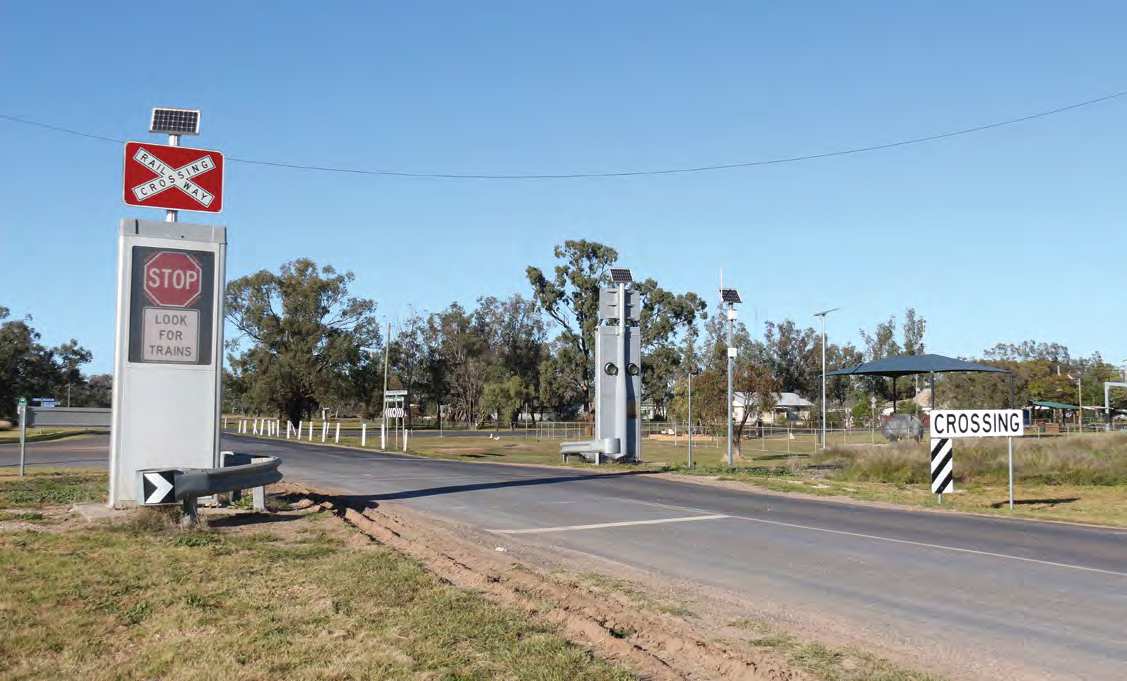
The importance of improving safety at regional level crossings was illustrated when the March 2022 Federal Budget included $180 million to establish the Regional Australia Level Crossing Safety Program. The funding includes $160 million for upgrading level crossings, $6.5 million to deliver a national level crossing safety education and awareness campaign, $5 million to support research into and trials of new level crossing technologies and safety measures and $2 million for improved data collection and risk assessment for level crossings.
With ever increasing road traffic levels and truck sizes any reduction of level crossing collisions between trains and road vehicles is very welcomed by the railway community. The goal of zero harm at level crossings is a challenging one to achieve but lower-cost active level crossing protection systems will play a crucial role alongside grade separations, improved train visibility at crossings and, most importantly, motorist behaviour education in contributing to reduced level crossing collisions.
References
- Tey, L., Ferreira, L., & Dia, H. (2009). Evaluating cost-effective railway level crossing protection systems. Proceedings of the 32nd Australasian transport research forum (ATRF), http://www.patrec.org/web_docs/atrf/papers/2009/1763_ paper7-Tey.pdf
- E.C. Wigglesworth, C.B. Uber. An evaluation of the railway level crossing boom barrier program in Victoria, Australia, Journal of Safety Research, Volume 22, Issue 3, 1991, Pages 133-140.
Special thanks to Dagmar Parsons and Peter Feder from Rail Safety Systems for their generous assistance in preparing this article. Thanks also to David Campbell for additional information.
The author has derived no financial benefit from organisations mentioned in this article and Railway Digest does not exclusively endorse the RSS development or any other level crossing protection system.
Download a copy of the original article here.

